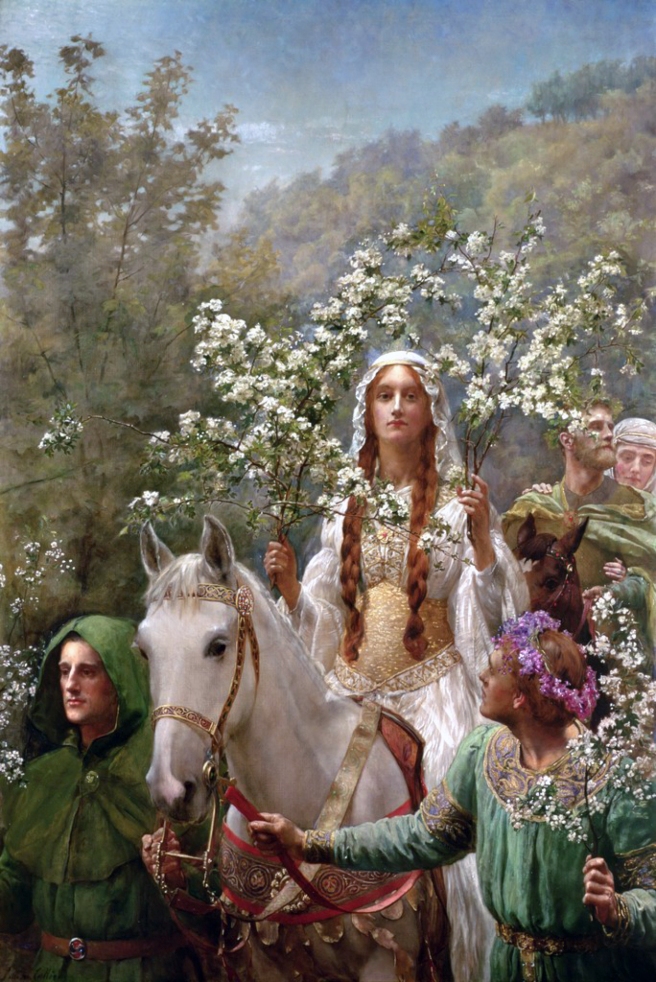The Season of May. Summertime has commenced! Sumer is a cumen in! May’s Eve. Walpurgis. May Day. Beltane.
These and more are heralds of our current season. May Day has a long, storied, folkloric history, both in America and abroad, especially within the British Isles. For me and other Pagans, Beltane is a time of fecundity and sexuality. My focus is on the Arthurian tradition and so I find inspiration from the Queen of the May herself, Guinevere.

Queen Guinevere’s Maying by John Duncan, 1900
Guinevere
You are the Lady of the first half of the year
White Shadow
Is proclaimed both far and near
In the Spring you appear
White Shadow
Becomes the cheer
May flowers adorn May deer
White Shadow
Summer’s here
Pass the mead, pass the beer
White Shadow
Solstice is here
Listen to the tale, gather near
White Shadow
She shall appear
You are the Lady of the first half of the year
White Shadow
Goddess, Queen: Guinevere.
* * * * * * * * * * * * * * *
The most famed lady of the Arthurian realm, her original Welsh name is Gwenhwyfar, and translates as “white shadow.” Known as King Arthur’s queen, Guinevere was probably originally a Goddess who bestows kingship on the rightful: She is Sovereignty.
Sovereignty is the Goddess of the Land. Her form is not as obvious in the Arthurian realm as it is throughout Celtic myth in general, most especially within the Irish, but she is here, nonetheless. Caitlín and John Matthews (1992) name her the Flower Maid or Bride and write that she is on “loan to us from the world of Faery,” (p. 28). She is Otherworldly, yet it is from being in her bed that the king remains in power. These stories relate the ancient mythic rites: At Beltane, the Sacred Marriage is enacted and the Year King is chosen. He whom Sovereignty chooses rules the land until he is deposed at the following Beltane when another is chosen.
In the case of King Arthur, his “union with the land, the Goddess of Sovereignty, is a very special one characterized by an exchange of energies and powers: The king swears to uphold his land and people and to be true to them, while Sovereignty gives him otherworldly gifts enabling him to keep his oath.
Arthur’s relationship with Sovereignty is an extraordinary one, for not only does he relate to otherworldly and earthly women who represent some aspect of the Goddess, but also his role extends to selecting knights of his court, his champions, who similarly relate to the figures of Sovereignty” (Matthews, 2002, p. 17).
The seeds of Sovereignty remain in Guinevere’s myths as Abduction Tales. She is abducted by Mordred, the son and/or nephew of King Arthur, one of the chosen great knights, who, as the king’s sister’s son has a right to the throne. Perhaps he steals Guinevere to cement his own kingship. Perhaps Guinevere recognizes King Arthur’s decline and imposes a new, rightful king in his stead. Guinevere is abducted many, many times in Arthurian mythos, by many different knights. When reading and thinking about these tales with Sovereignty as Guinevere’s true role, we no longer see her as a hapless victim, but as a Goddess placing the right, true king on the throne thus ensuring a prosperous land.
It is at Beltane, the time of May, when Guinevere as Sovereignty chooses the rightful king. They wed in sacred, sexual marriage and the good of the land is ensured for another year.
Bibliography
Matthews, Caitlín. (2002). King Arthur and the Goddess of the Land
Matthews, Caitlín and John. (1992) Ladies of the Lake

Wonderful blog about the May Queen in Her rightful rôle as Sovereignty. Great insights.
LikeLike
Also, I LOVE your poem.
LikeLike
Thank you!
LikeLike